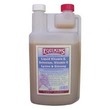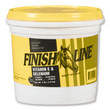Pronunciation
sa-LEE-nee-um - Pronunciation guide
Brand Names
- E-Se
- Equ-SeE
- Selenium
- Vitalize Equine Pasture Mate
Description
Selenium, in conjunction with vitamin E, is necessary for proper immune system function and to protect the integrity of cell membranes. However, a delicate balance exists between too little selenium and too much.
In many areas of the country, horses ingest sufficient selenium while foraging, but in other areas, selenium needs to be part of the horse's diet. Chronically selenium-deficient horses will often "tie-up" because of a degenerative condition of the muscles, known as rhabdomyolysis. Severe muscle cramps result in stiffness, sweating, and increased pulse. Broken-down cells can cause the horse's urine to appear brown.
Many different sources of selenium are available for horses. A free-choice salt/mineral mix containing selenium is the safest form of supplementation. When horses live in a selenium-deficient area, one consistent source should be used, and care should be taken to make sure the horse doesn't ingest several products containing selenium because of the danger of selenium toxicity.
In severe cases of selenium deficiency, an injectable product may be used to increase selenium levels immediately.
Usage
Selenium is used to supplement the horse's diet to prevent muscle cramps and breakdown of muscle cells that cause "tying-up." Adequate selenium in the diet is also necessary for a healthy heart and respiratory system.
Lack of selenium in the diet may impair reproductive performance and decrease resistance to disease. In cases of severe selenium deficiency, an injectable product may be used for immediate relief, with oral supplementation used thereafter.
Selenium is also combined with other vitamins, minerals, and nutrients as a supplement.
Dosage and Administration
| Selenium | ||||
|---|---|---|---|---|
| Method | Dosage (click row for calculator) |
Concentration | Period | Duration |
| Oral | 0.3 mg/kg 1 | Daily | NA | |
| Intramuscular injection | 2.5 mg/100lb | 2.5 mg/ml | Daily | NA |
Notes:
|
||||
Side Effects
Excessive intake of selenium will result in chronic selenium toxicity, also called "alkali disease."
Precautions
Cases of toxicity, due to selenium in water, excessive use of supplements, or environmental contamination have been reported. Follow the advice of a veterinarian who knows the area where horses forage and can determine whether or not a selenium supplement is needed to prevent danger of toxicity.
In some cases, a veterinarian may take a blood sample and have it analyzed for concentrations of selenium or gluathione peroxidase, an enzyme that requires selenium.
Interactions
None reported.
Overdose
Overdose is characterized by watery diarrhea, high temperature, weak and rapid pulse, labored respiration, blue mucous membranes, and dilated pupils. Selenium toxicity can lead to death, so the services of a veterinarian should be sought at the first indication of toxicity.
Images
 Equimines Selenium Liquid Solution with Vitamins C and E, Ginsin
Equimines Selenium Liquid Solution with Vitamins C and E, Ginsin
 Finish Line Selenium Powder with Vitamin E
Finish Line Selenium Powder with Vitamin E
